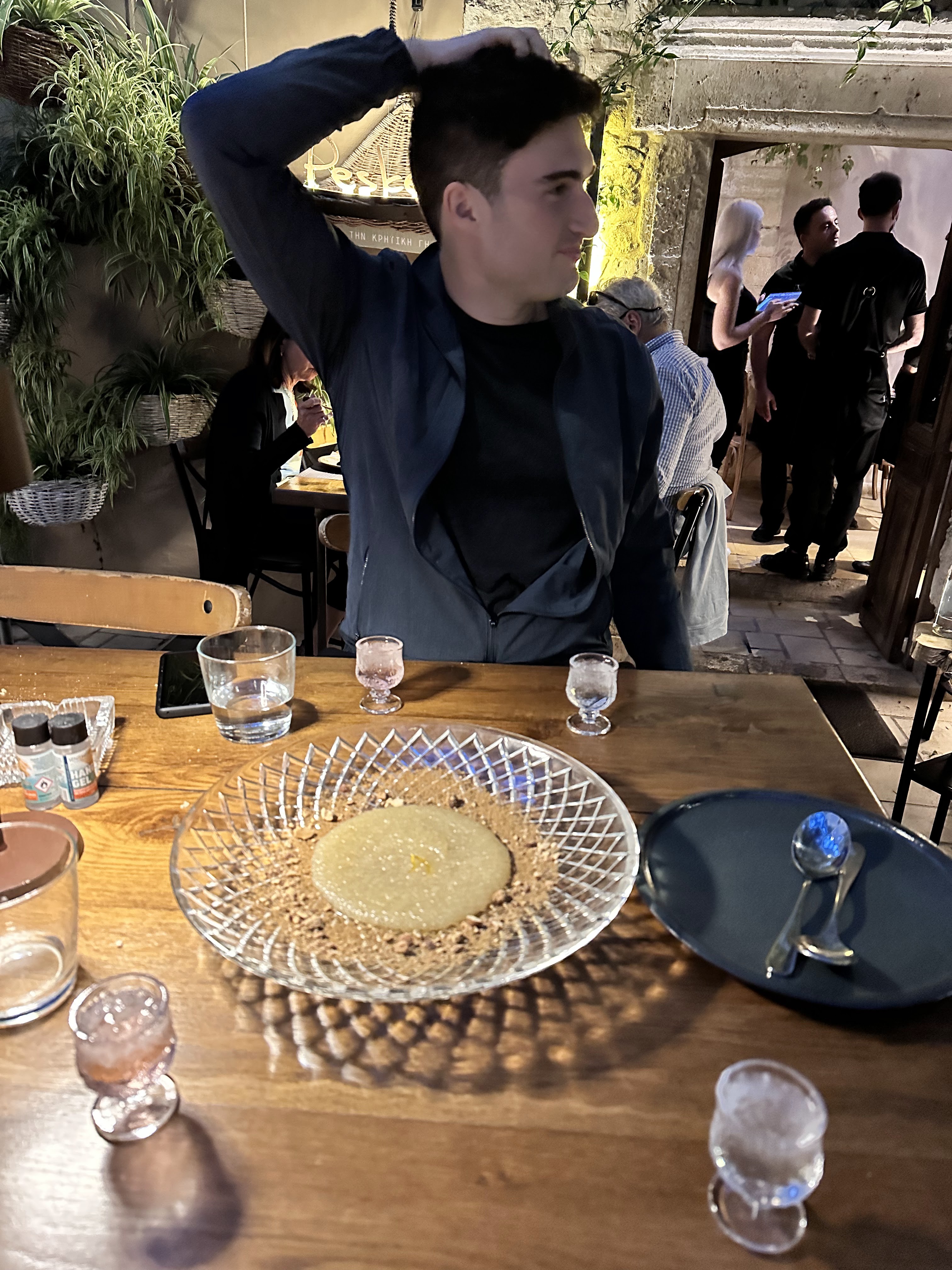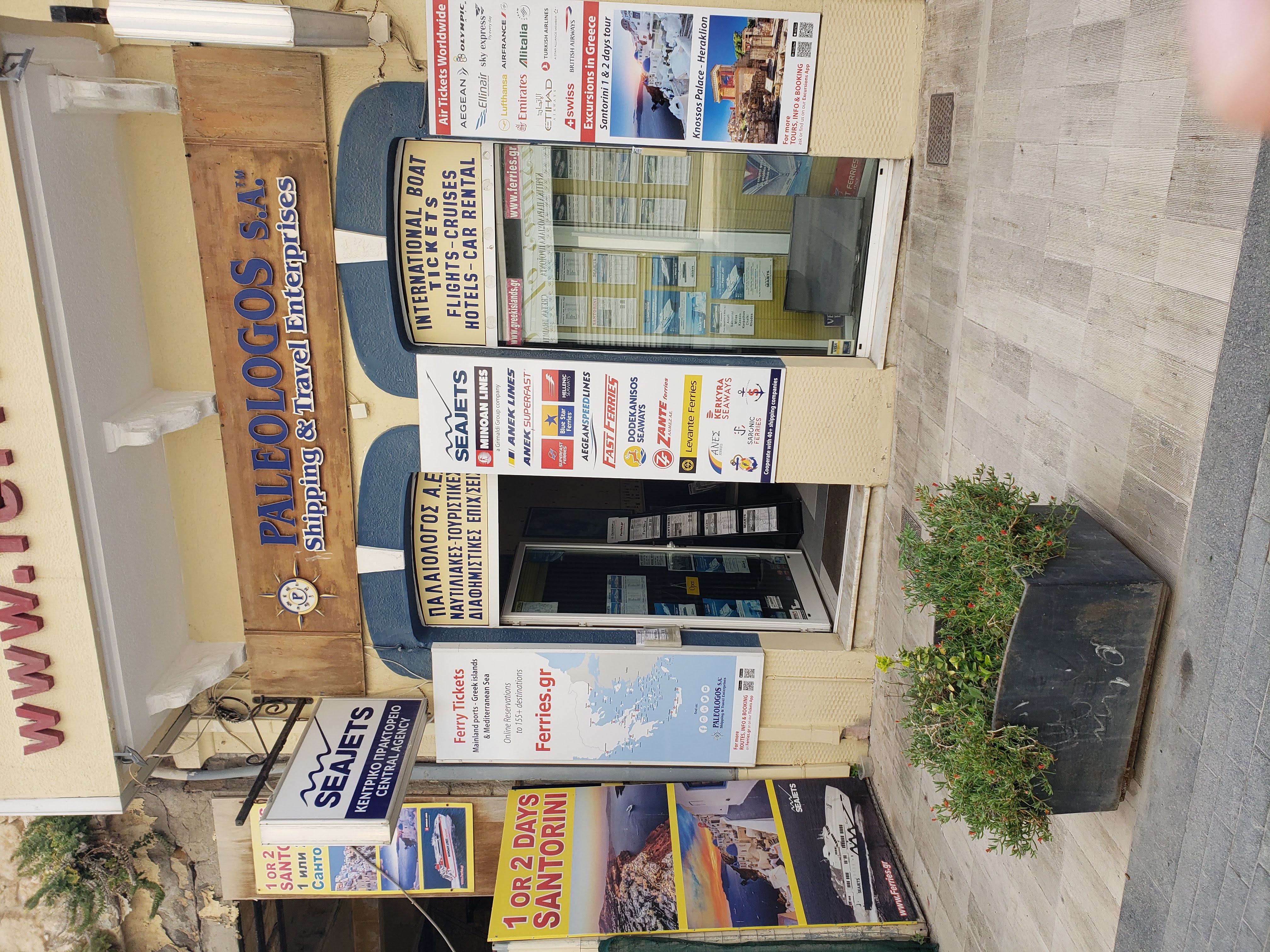
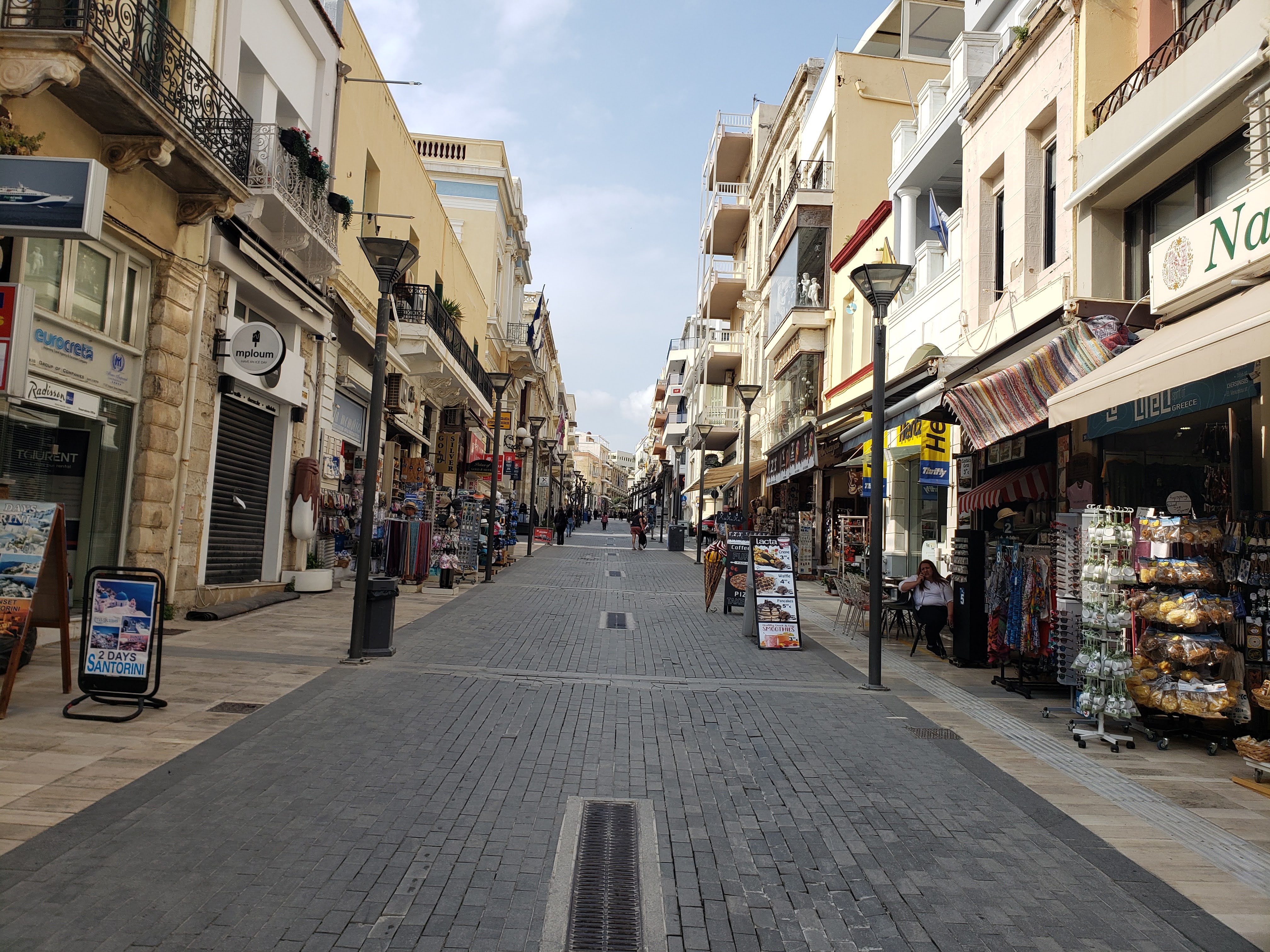
In the morning Lizy and I walked to the parking lot where we had left our car the previous night. I had dropped off the car by myself the night before and so led the way. I got a little lost on the way there and stumbled upon a museum of ancient Greek technology. It looked like they had a lot of cool devices in the museum, so I convinced Lizy that we should stop for a while in the museum.
The museum was spread among two cramped floors. The concept was that an engineer had scoured ancient sources for devices and then rebuilt the devices to display in the museum. Some of the sources were from famous technologists such as Pythagoras and Archimedes and some were less famous.
At the beginning of our visit a young woman did some demonstrations for us. The first device she showed us was a cup, whose design was described by Pythagoras. It was designed to be the physical embodiment of the saying, “If you are too greedy, than you will receive nothing.” It was a metal cup with a single line engraved on the inside of the cup about three quarters of the way up. If you filled the cup to any point below the line, it would function like a normal cup, but if you filled the cup above the line the liquid from the cup would be ejected from the cup, and not just the liquid above the line, but all the liquid in the cup.
She also showed us a water fountain that did not require an electric pump to run. The fountain was kicked off by pouring some water into a chamber in the fountain and then the water forced air out of a lower chamber into an upper chamber ejecting the water in that chamber from the fountain. The device would continually spurt water for about 10 minutes before the energy dissipated from the system. She also showed us a device for pouring wine mixed with water that allowed one to control the ratio of water and wine in the final mixture.
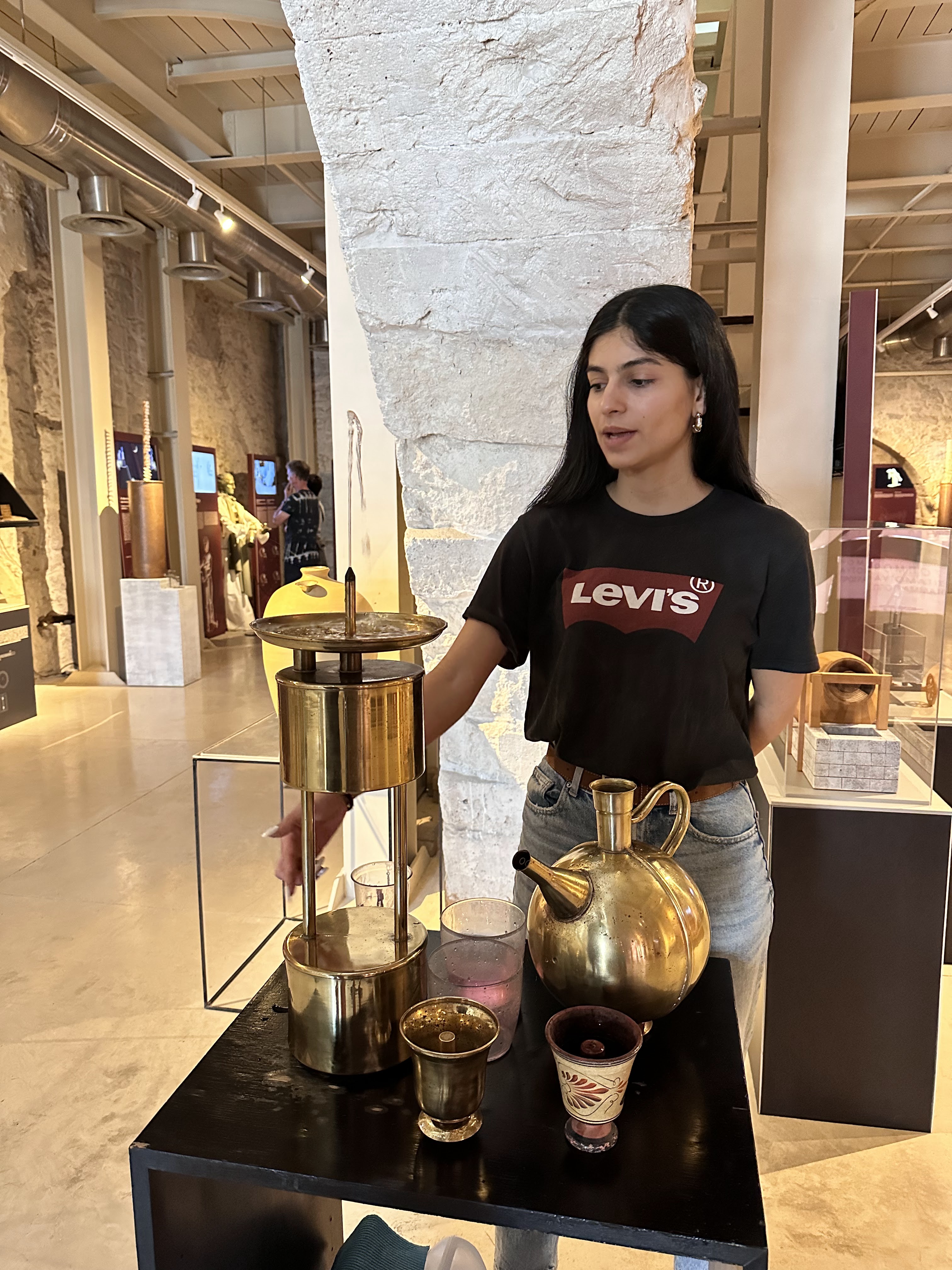
Some of the other highlights of the museum were different types of clocks using the gravitational potential energy as their energy source, mechanical theatres (think of moving dioramas) powered by falling sand, ancient games, recreations of the platonic solids and other convex polyhedrons, and a rebuilt version of the Antikythera device. The Antikythera Device is the celestial body computation device we saw the remains of in the Archeology museum in Athens. A man who was one of the confounders of the museum played a game of ancient tic tac toe with me, but he got tired of waiting for me to make moves and went ahead and played four moves for both of us. The end of which culminated in my victory. Afterwards he talked to us a little bit about the founding of the museum. His partner who built the devices had his workshop near Olympia in the Peloponnese and there they had another location that was slightly larger, to which Lizy said, “What a surprise the best thing in Heraklion is from the Peloponnese.” After looking through all the devices we bought a clay version of the Pythagoras cup and one of the ancient Greek boardgames from their gift shop.
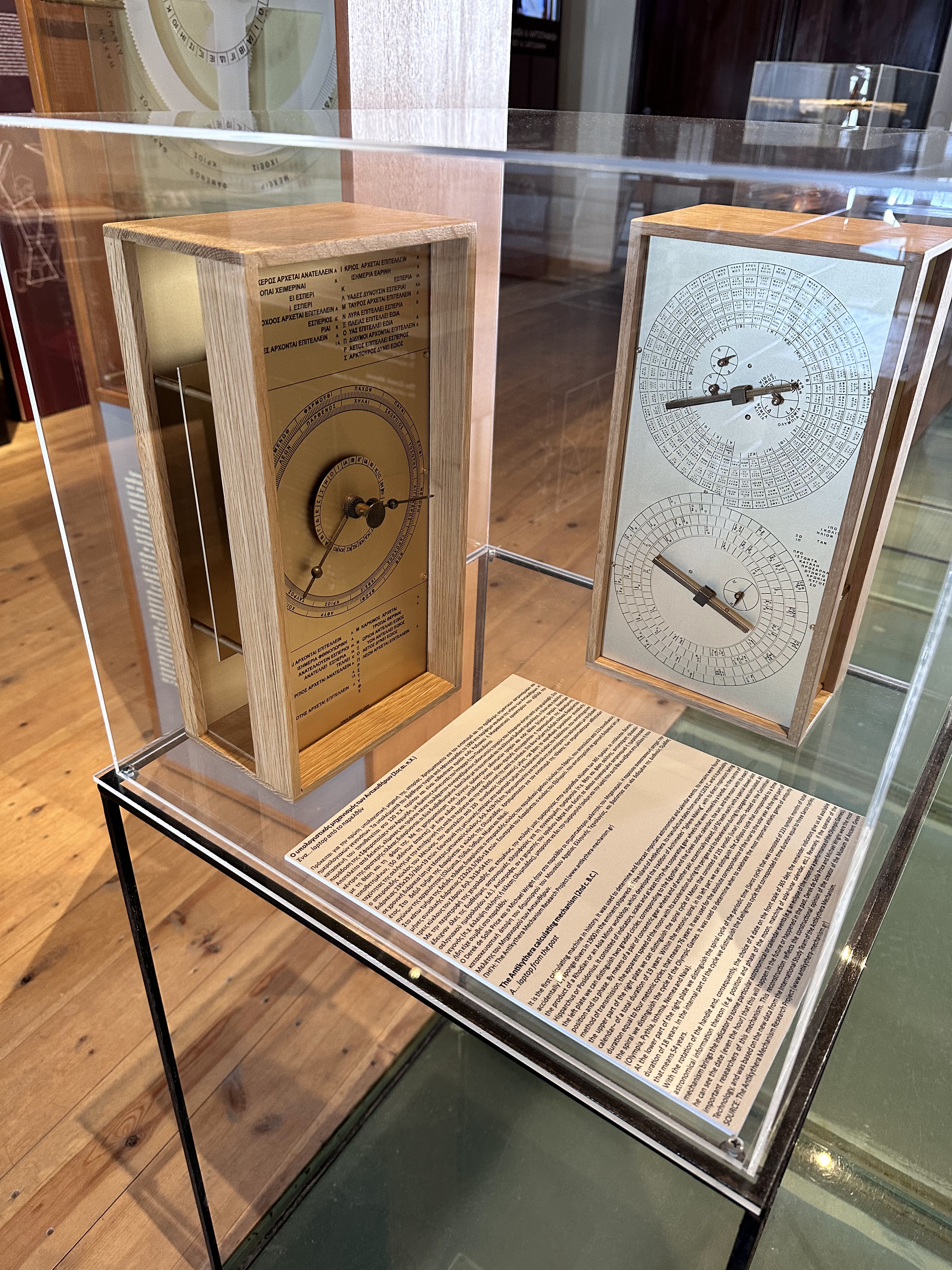
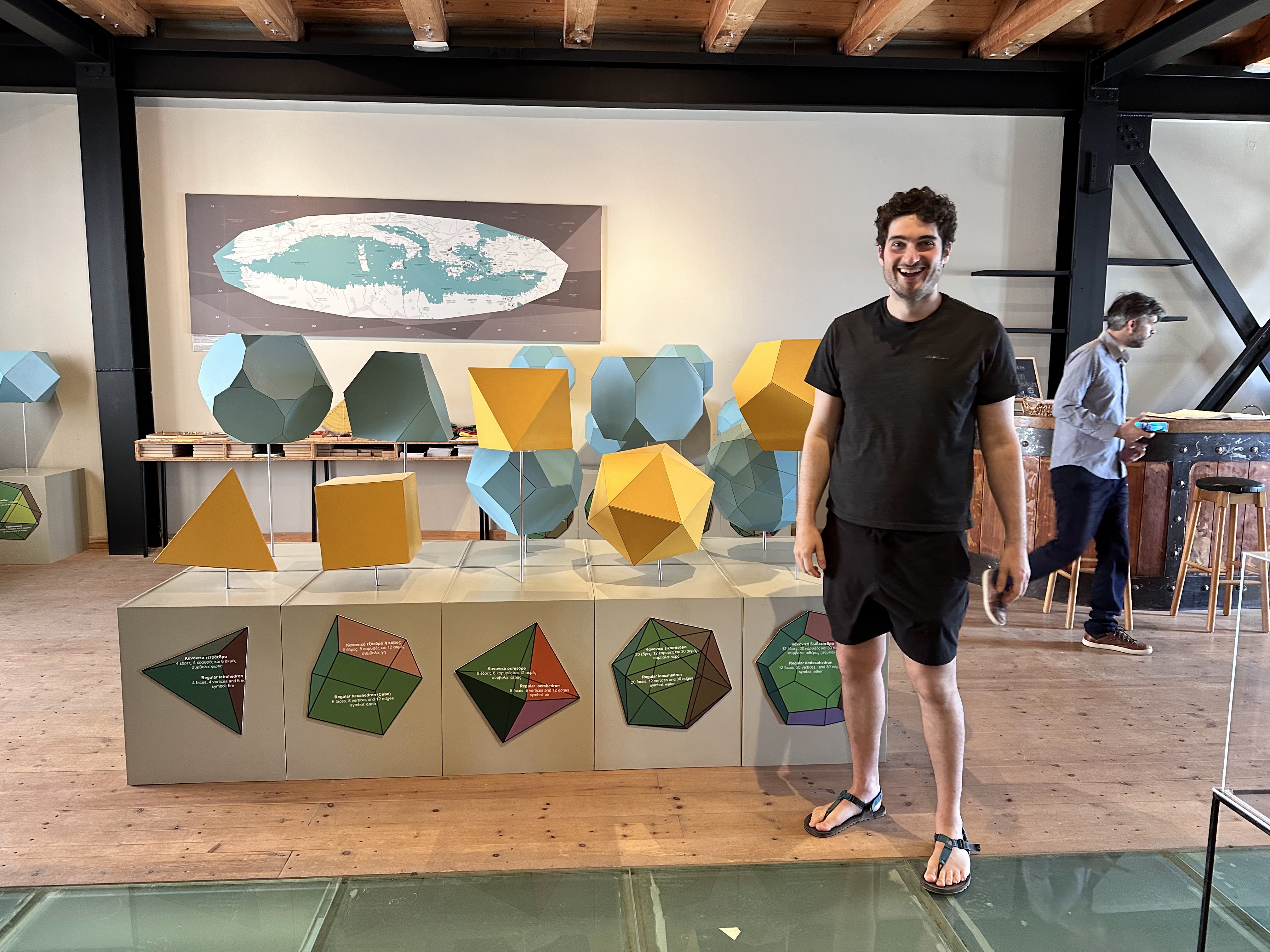
After picking up the car from the garage, we drove to the archeological site of Knossos. Knossos was the palace of the ancient Minoan civilization. The civilization flourished between 2000 BC and 1450 BC. It was a contemporary of the Mycenaean civilization, which was the civilization that had built Mycenae, an archeological site we previously visited in the Peloponnese. The two civilizations used similar writing systems of hieroglyphics called Linear A, however the Minoans’ Linear A has yet to be fully deciphered unlike the Mycenaean’s Linear B. Since we have no prose writing from the Bronze age what we know of the civilization comes from the archeological evidence and mythical writings from the Greek classical age, including the writings of Homer. Unlike the Myceneans, the Minoans were a peaceful civilization and unlike Mycenae, Knossos was not built to be easily defensible. There was cultural transfer between the civilizations, evidenced by works of Minoan artworks found in Mycenae, probably the result of cross civilization commissions and trade. Eventually Knossos was captured by the Myceneans before both civilizations collapsed at the end of the bronze age.
We were hungry so we ate lunch at a restaurant just outside the archeological site of Knossos. They claimed to have Minoan dishes, but I doubted the possibly that recipes could have been passed down orally from prehistory. Lizy, less cynically, was able to “just enjoy the food.”
Outside Knossos there were guides in a kiosk just before the entrance. People would wait for a group of 4 or 5 people that spoke their language and then split the cost of one of these guides. We decided to get a guide and we ended up in a group with two early 30’s, Australian women and a late 40’s Canadian man. Our tour guide was a man in his mid 40’s with a flair in his speech from Knossos the town, specifically lower Knossos. He told us small towns in Greece often came in pairs a lower in an upper town.
The Australian girls were on a longer trip together through Greece. They had come from Rhodes, which they traveled to via an overnight ferry. They seemed somewhat overwhelmed by their travels and talked of how Greece was harder to navigate then they had thought it would be. Everything seemed smaller on the map and they couldn’t believe how large Crete was. Lizy told them she agreed with them about Crete, and that she too had thought it would be much smaller. Lizy told them that if they were single, maybe give Sfakia because it seemed to be inhabited by exclusively big, burly men who drove pickup trucks. It also seemed like it’d be more relaxing than staying in Heraklion or Chania. They said they’d consider it and we gave them the name of the family taverna we had eaten lunch at in Illingas.
The Canadian was on a solo motorcycle trip that had started in Germany and weaved it’s way through the Balkans before getting to Greece. Back in Vancouver he worked as a helicopter pilot, which I should’ve figured out because he was sporting a company t-shirt. He mostly did sightseeing tours, but recently he had flown the crew of a new conspiracy theory show on the History Channel. The show was called Dead Man’s Gold and he claimed to be in an episode in the upcoming season.
Mariano was an engaging guide. He told us about the history of the archeology. It was originally operated as a private for profit excavation site under the ownership of the Englishman Sir Arthur Evans. Sir Arthur Evans not only excavated the palace, but had chosen to reconstruct much of the palace using concrete and paint, to give visitors a better sense of the what the palace looked like in antiquity. Due to his enhancements he was able to run the site as a profitable tourist attraction for many years, until he sold it to the Greek government.

The walls were decorated with modern frescoes, which were recreations of incomplete frescoes found at the site and moved to various museums for preservation. There was one large fresco depicting a bull. Mariano told us this represented the Minoans’ love of bull fighting, a sport, which unlike modern bull fighting did not result in the death of the bull, because of the Minoans’ deep love of bulls. Sir Evans had also recreated the throne room. The throne and wash basin were original iron, and the entrance ways and paintings were modern recreations.
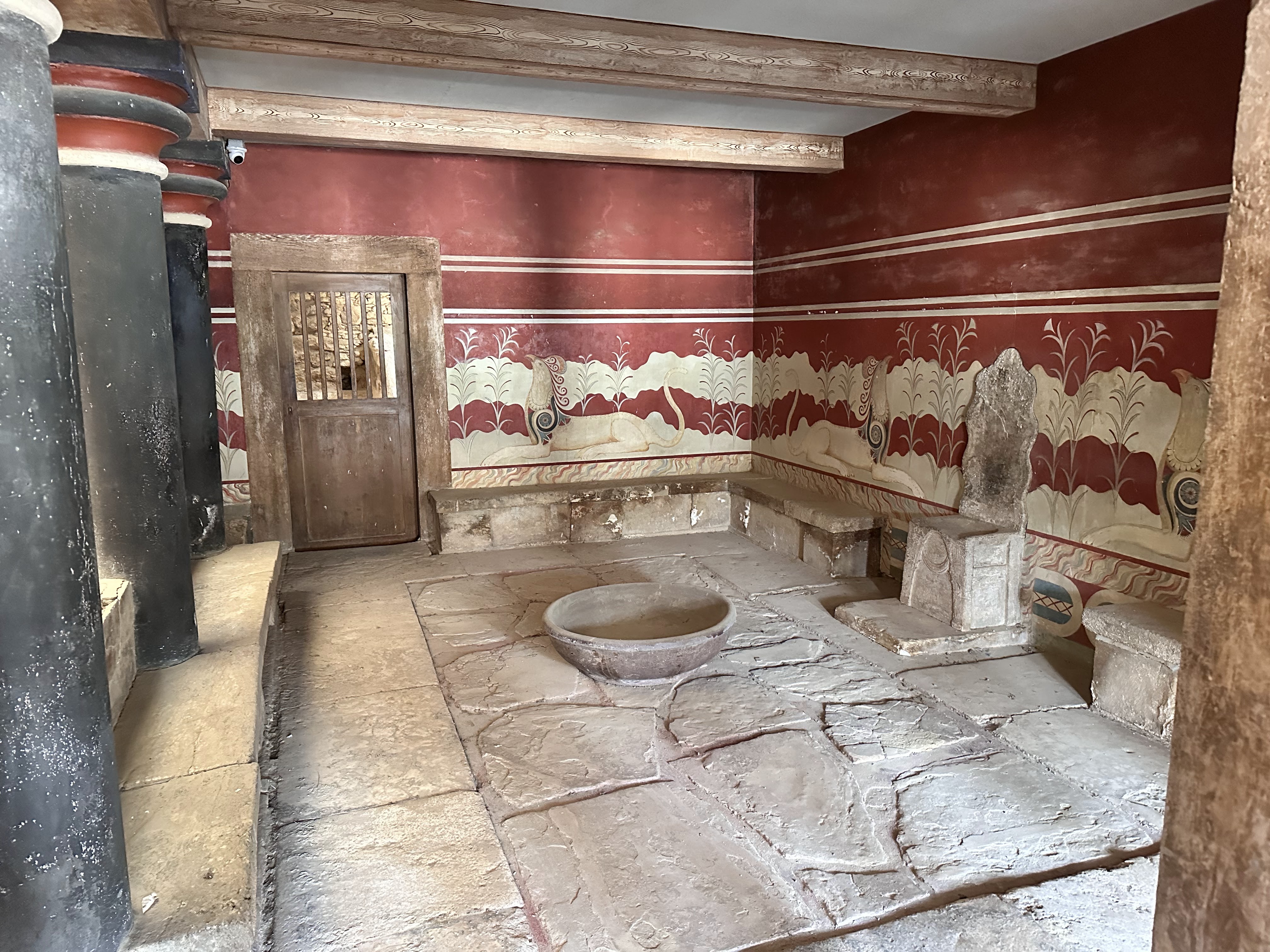
At the end of the tour we saw the the small Minoan theatre. It was impressive for how old it was, but much smaller than the classical theatre we had seen in Epidavros. Since there are no literary sources from Minoan times, we have no idea what a Minoan would have seen at a theatre. I’ve heard people say that drama was invented in the golden age of Athens, which would imply that 1000 years earlier the Minoans would have to be doing something other than putting on plays in their theatre. Perhaps, poets would recite epic poetry. It’s now widely believed by scholars that Homer’s epic poems are canonizations of older oral poems. Each retelling would change the story a little bit. Add some new flair. Maybe the early seed of the Odyssey was planted by a poet on this stage, I thought. But who knows for sure.
Since there are no surviving works from Minoan times, a lot of what we think we know about the civilization comes from the classical Greek myths. Mariano told us one such myth, standing at the theatre which I will repeat here as he told it:
“A long time ago, the king of Knossos, King Midos, received a beautiful bull as a gift. When he was given the bull, he was instructed to sacrifice the bull to Zeus. However, the bull was so beautiful that he couldn’t bring himself to sacrifice it. At the last moment he switched out the beautiful bull, for another less beautiful bull.
“No other mortal saw what he had done, but there was one flaw to Midos’s plan; the gods of Olympus were all seeing. Zeus decided to punish him by making his wife fall in love with the bull. The wife’s desire for the bull grew day by day, until one night she couldn’t take it anymore and snuck into the stable to be with the bull.
“She became pregnant with the bull’s child. King Midos was very embarrassed by the whole incident, and especially so when his wife gave birth to a half bull, half man monster, the so called Minotaurus. So as to put the incident behind him, King Midos constructed a labyrinth that he could hide Minotaurus in. The labyrinth was so elaborate that it was impossible for Minotaurus to find his way out. To feed the beast King Midos once a year sent a group of three boys and three girls into the maze. None of the tributes ever exited.
“This went on for many years, until one day the hero Theseus fell in love with one of the daughter’s of King Midos. To impress her father he decided to kill Minotaurus. The princess aided Theseus by giving him one end of a long string, while she held onto the other end at the entrance of the labyrinth. Theseus entered the maze, killed Minotaurus, and then exited the maze using the string.
He married the princess, but later he left her and coupled up with another princess who bore him many mythical figures, including Icarus.
There’s always some historical truth that inspires the myth. The question becomes how much is historical truth and how much is fabrication. So what part of this story do I think is the truth? All of it.”
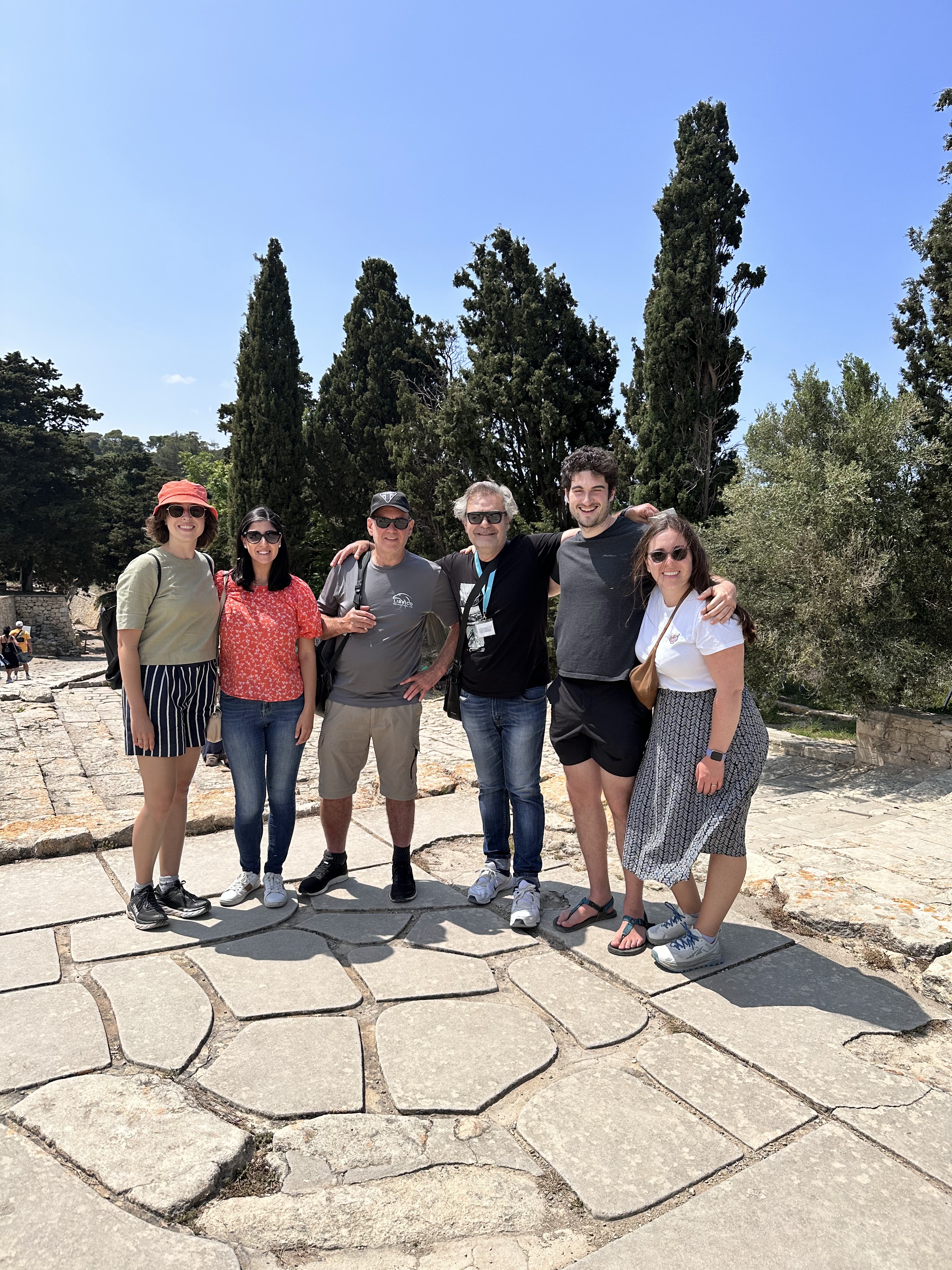
This was the end of our time at Knossos. Upon exiting, we drove to a beach, that, in ancient times, was the site of the port for Knossos. The port of Knossos features prominently in Odysseus’s journey home as told by Homer. Today it is the site of a beach bar. The bar was blasting house music across the beach. There were beach chairs, boat rentals, and volleyball courts. Waitresses weaved between the seats taking drink orders. It seemed like most of the patrons were local Iraklionites.
Across from the beach was a small island, consisting of a jumble of rocks. Maybe 100m across, but it was hard to tell from the beach. On top of the pile of rocks was a Greek flag. I told Lizy that we should try to swim to the island. She did not think it was a good idea, as the water was rough and the island was far. I told her, well let’s see how far we can swim then we’ll turn back, we don’t need to swim to the island.

The beach was sandy, and it stayed shallow for quite some time. Once we got past the shallow section, the water depth seemed to level out at around 8 feet. Lizy tried to convince me to swim with her back and forth parallel to the beach, but I wanted to keep swimming against the waves closer to the island, so I kept going leaving her behind.
I swam further and further. When I was tired I would lie on my back and look at the oncoming waves. It was easy to float because of the saltiness of the sea, so I always stayed fresh.
At a certain point I could no longer see Lizy, but I kept going. The water was still clear and I could see the sandy bottom. The island was getting closer. There were two pedal boats with Greek men in my general vicinity that came into my view.
I swam past one of the pedal boats. One of the 20’s something Greek guys asked me if I was tired. I told him I wasn’t. He looked skeptical. Between the two boats there were 7 guys and one girl. The guys looked tough, well maybe it was because they were on a boat and I was in the water, but that’s how it looked to me, so I swam past them instead of stopping to engage in a lengthier chat.
Nearer to the island the ground finally changed from sandy to rocky. I still didn’t see fish, but maybe there’d be some hiding amongst the rocks. Then it starting getting shallower coming up to the island. I considered turning back, but decided to cap off the journey by standing on shore of the island. Maybe Lizy would see me and take a picture, and then I’d be able to put it in this blog.
I got to the island and stood on one of its rocks. I felt the sharp rock on my bare foot. Maybe I should’ve worn sandals, I thought. I waved at where I thought Lizy might be on the shore, but I doubted she could see me. I certainly could not make her out on the beach in the distance.
Now that I was on the shore, I figured I might as well see how hard it would be to climb up the mound of rocks. Maybe stand next to the flag. Would be even better in the photo, that it seemed Lizy would be unlikely to take. I took a couple of steps, but the path seemed unnecessarily precarious. Even if I didn’t fall I was at least likely to get a cut on my foot. Why did I feel the need to get to the flag anyways? I turned around towards the beach again, to look for Lizy on the shore.
One of the pedal boats had pedaled up almost to the shore of the island. It was the boat with four guys, without the woman.
“Hey,” one of the guys yelled.
“Ya,” I yelled back.
The guy yelled some more to me. I couldn’t quite work out what he was saying, over the sound of the waves, but it sounded menacing. He may have been warning me of the dangers of the island. Saying something like, “If you try to climb up to the flag you will be killed. You’ll smash your head on a rock.” But he may have also said something like, “If you go up to the flag, I’ll kill you. I’ll smash a rock over your head.” Either way I decided to heed the man’s warning and started climbing back into the water.
The boat turned around. I swam back veering far away from the pedal boats. The way back seemed much faster. Maybe because I was swimming with the waves. When I got back closer to the beach I found Lizy waiting for me in the water. I was surprised to see her in the water, I thought after all that time she’d go back to the shore. Well, she wanted to kiss in the water before we headed back to the beach together and so we did.
“You’ve been swimming this whole time?” I asked.
“No when I lost site of you, I freaked out and went to see the lifeguard. I told him my husband was going to widow me on our honeymoon. He didn’t seem to be too concerned. He told me he had seen you swim out but he had lost sight of you. I told him what do you mean you lost sight of him, you’re the lifeguard. Again in the most relaxed possible way, as if nothing was wrong, he told me he’d look for you with his binoculars. He found you with his binoculars and showed me where your were. Then I watched you for a while with the binoculars, because it was clear that this guy was not going to keep his eye on you. The lifeguard turned to me, while I had my eyes glued to the binoculars, and told me, it’s better to have an adventurous husband that makes you worried, than have a boring husband.”
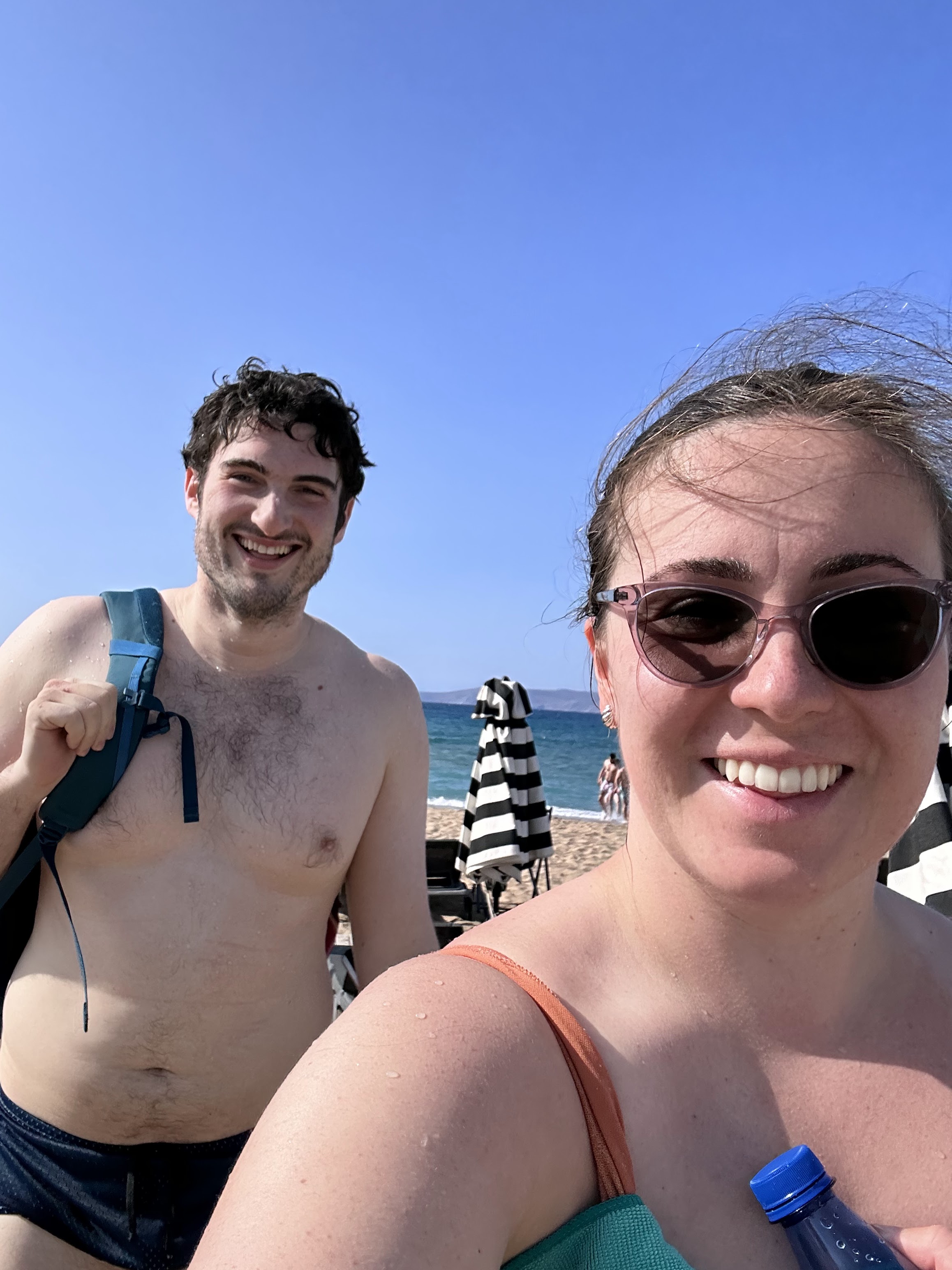
We went back to our loungers. After Lizy finished her glass of wine, we had to rush off to return our rental car. We got to the rental return spot at the airport no problem, and one of the attendants gave us a ride back to our hotel. On the way back I saw a barber. I asked the driver if it was a good place, thinking I might come back to get a hair cut, but when he said yes and that he had a friend that worked there I thought, why don’t I just go now. I jumped out of the car at the next red light and started running back to the barber. I think the driver thought I was crazy.
The hair cut place was in a large building with clear glass window walls at the front, as if the hair cutting was a performance for pedestrians on the street. The barber shop was very busy, but they had a lot of capacity and could take me right away. My barber was a Greek woman in here early 40’s. She had a tattoo of hair clippers on her left arm, with an artful handle made of vines. It was so artful, I was a little unsure they were hair clippers so I asked to confirm, and the woman told me that yes the tattoo was a pair of scissors, “Cutting hair is more than a job for me, it’s a passion.” On her other arm she had a tattoo of a young girl sitting on a tree branch. She told me her sister had a matching tattoo. I said that she and her sister must be very close. She said you know how it is with sisters, even when you hate them, you love them.
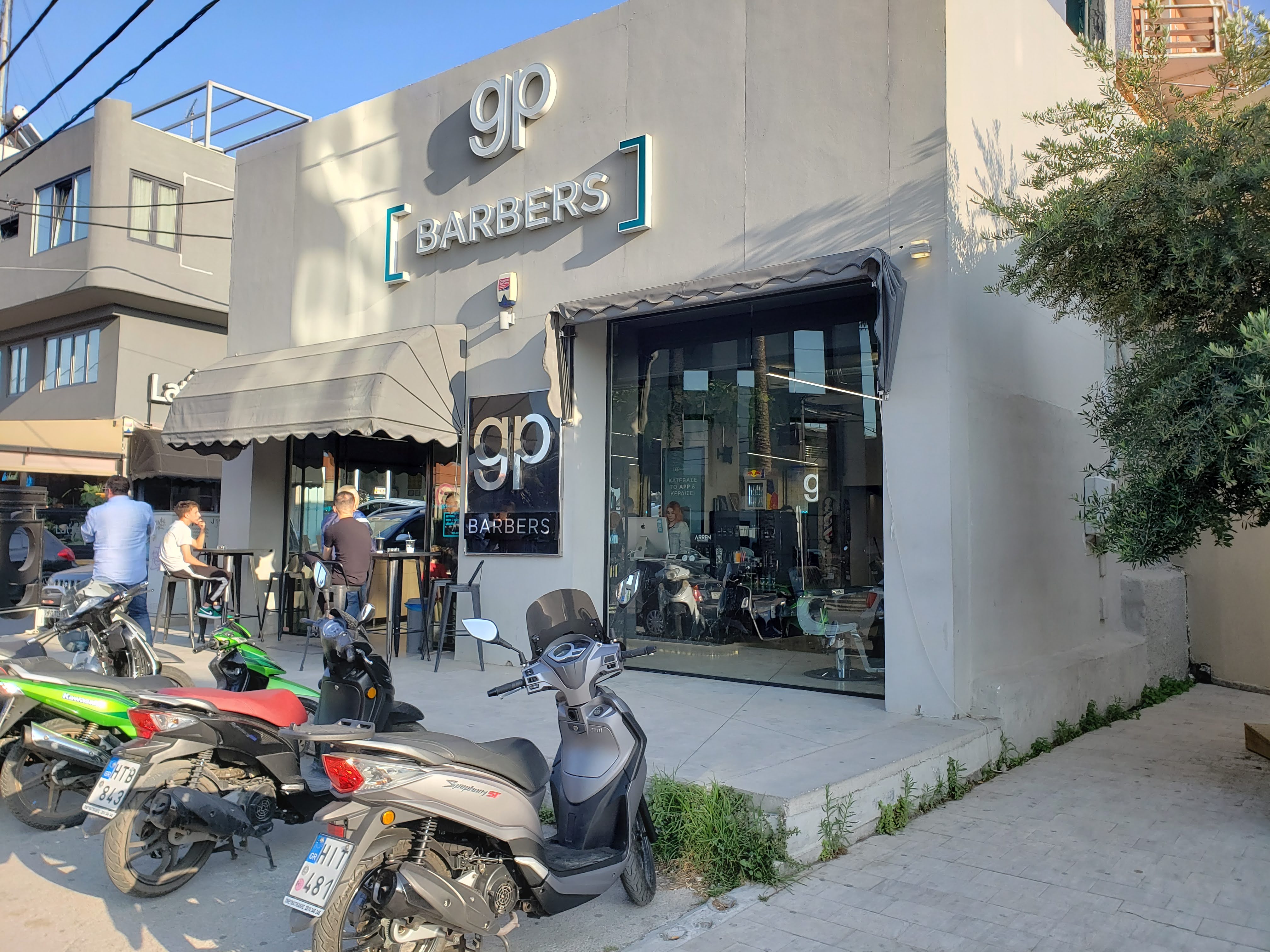
I told her about the guys that had yelled at me when I was standing on the little island at the beach. I assumed she would laugh and tell me they were definitely just trying to keep me from getting hurt, but she turned to me with kind of a solemn look on her face, and told me they were definitely threatening me. There was a thing about that island. Certain Greeks believes that if that flag was removed another country would be able to invade the island. It seemed silly to me, why would anyone want to invade that little jumble of rocks, but I was reminded of what Carl had told us back in Kardamili, that Cretans were really into vendettas.
I was really happy with the haircut I got. I should’ve expected no less from someone with a tattoo of hair clippers. After paying, I went to walk out of the barber shop and ran right into the clear glass wall at the front of the store. It seemed as if the whole building trembled, and everyone stopped what they were doing to look at me. I was just barely able to stop myself from falling onto the ground, but I felt super disoriented for a few seconds. People asked me if I was ok. I said I was. I felt quite embarrassed. I exited as fast as I could and walked back to the hotel.
I met up with Lizy at the hotel and we walked to the restaurant we had reservations at in the city centre. I thought the food was quite good. In classic Crete fashion they gave us free desert and shots of ouzo at the end of the meal. The waiters got confused and accidentally both brought us out a shot, so we got two shots each. On the way back we walked slowly back to the hotel through the streets again. They didn’t let cars on these streets to make them more pleasant for pedestrians.
I turned to Lizy, “See Heraklion ended up being nice.”
“Ya if you’ve never seen nice.” she retorted back.
